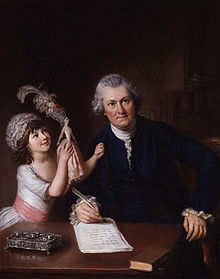- Christopher Anstey
-
Christopher Anstey 
Christopher Anstey with his daughter, by William Hoare, circa 1777Born 31 October, 1724
Brinkley, CambridgeshireDied 3 August, 1805 (aged 80)
Bath, SomersetNationality English Occupation writer, poet Notable works The New Bath Guide (1766) Christopher Anstey (31 October, 1724 – 3 August, 1805) was an English writer and poet.
Anstey was the son of Dr. Anstey, a wealthy clergyman, the rector of Brinkley (Cambridgeshire) where he was born. He was educated at Eton College and King's College, Cambridge,[1] where he distinguished himself for his Latin verses. He became a fellow of his college (1745); but the degree of M.A. was withheld from him, owing to the offence caused by a speech made by him beginning: "Doctores sine doctrina, magistri artium sine artibus, et baccalaurei baculo potius quam lauro digni" (Doctors without doctrine, artless Masters of Arts, and Bachelors more worthy of the rod than the laurel). In 1754 he succeeded to the family estates and left Cambridge; and two years later he married the daughter of Felix Calvert of Albury Hall, Herts. For some time Anstey published nothing of any note, though he cultivated letters as well as his estates. Some visits to Bath, however, where from 1770 until his death in 1805, he made No. 4 Royal Crescent his permanent home, (albeit the plaque recording this is actually displayed outside No. 5) [2] where in 1766 he penned his famous rhymed letters, The New Bath Guide or Memoirs of the Blunderhead Family..., a satirical poem of considerable sparkle, about the adventures of the "Blunderhead" family in Bath, from which Tobias Smollett is said to have drawn largely in his The Expedition of Humphry Clinker. The work had immediate success, and was enthusiastically praised for its original kind of humour by Walpole and Gray. The Election Ball, in Poetical Letters from Mr Inkle at Bath to his Wife at Gloucester (1776) sustained the reputation won by the Guide. He made many other excursions into literature which are hardly remembered, and ended his days as a country squire at the age of eighty. His Poetical Works were collected in 1808 (2 vols.) by the author's son John Anstey (d. 1819), himself author of The Pleader's Guide (1796), in the same vein with the New Bath Guide.
Anstey was buried at St. Swithin's Church in Bath but has a white marble memorial tablet in Poets' Corner (the South Transept) of Westminster Abbey.
References
- ^ Christopher Anstey in Venn, J. & J. A., Alumni Cantabrigienses, Cambridge University Press, 10 vols, 1922–1958.
- ^ Lowndes, William (1981). The Royal Crescent in Bath. Redcliffe Press. ISBN 978-0905459349.
- This article incorporates text from a publication now in the public domain: Cousin, John William (1910). A Short Biographical Dictionary of English Literature. London, J. M. Dent & Sons; New York, E. P. Dutton.
 This article incorporates text from a publication now in the public domain: Chisholm, Hugh, ed (1911). Encyclopædia Britannica (11th ed.). Cambridge University Press.
This article incorporates text from a publication now in the public domain: Chisholm, Hugh, ed (1911). Encyclopædia Britannica (11th ed.). Cambridge University Press.
External links
- Works by or about Christopher Anstey in libraries (WorldCat catalog)
Categories:- 1724 births
- 1805 deaths
- People from East Cambridgeshire (district)
- English poets
- Old Etonians
- Alumni of King's College, Cambridge
- Fellows of King's College, Cambridge
Wikimedia Foundation. 2010.
